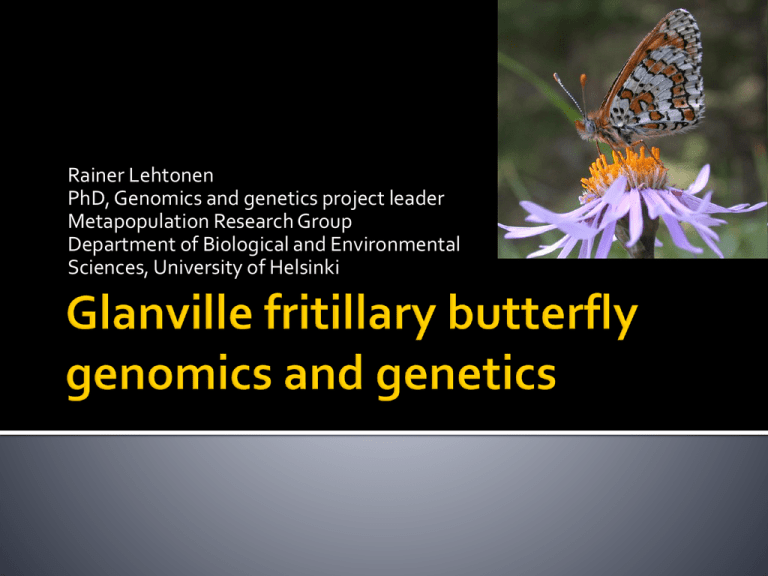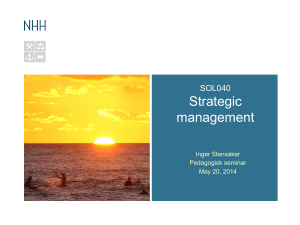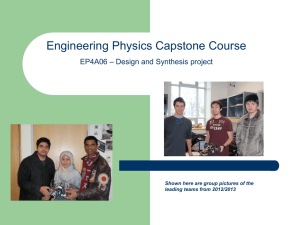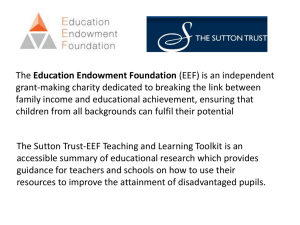Glanville fritillary butterfly genomics and genetics
advertisement

Rainer Lehtonen PhD, Genomics and genetics project leader Metapopulation Research Group Department of Biological and Environmental Sciences, University of Helsinki Background Genome project Genome assembly >> Panu Somervuo Some NGS applications Conclusions 2 Glanville fritillary is an internationally recognized metapopulation model system in ecological and evolutionary studies Studied since 1991 in the Åland Islands in Finland Data available from different populations: - Fragmented landscape vs. continuous Isolated vs. metapopulation Large vs. small Same vs. different population history Field studies, indoor & outdoor cage + laboratory experiments, controlled crosses, molecular studies 3 DNA (+RNA) SAMPLES INSTITUTE OF BIOTECHNOLOGY SEQUENCE DATA PRODUCTION INSTITUTE OF BIOTECH, KAROLINSKA INSTITUTE QC + ASSEMBLY INSTITUTE OF BIOTECH, DEP COMPUTER SCI ASSEMBLY VALIDATION (ref g) INSTITUTE OF BIOTECH, DEP COMPUTER SCI ANNOTATION + PUBLICATION EBI, ENSEMBL GENOMES GENOME ANALYSIS EBI, OTHER GENOME PROJECTS VARIATION IN THE GENOME INSTITUTE OF BIOTECH, DEP COMPUTER SCI GENETIC TOOLS FIMM, BIOMEDICUM HKI, INSTITUTE OF BIOTECH, ILLUMINA INC. 4 NEX-GEN SEQUENCING 454, SOLiD3, SOLEXA REF DNA +RNA SAMPLES EST ASSEMBLY ESTs GENOME ASSEMBLY NEX-GEN RE-SEQUENCING SOLiD4/SOLEXA CROSSES/POP POOLS/INDS MAPPING TO REF GENOME VARIATION REF GENOME GENETIC MAP (MARKER LOCATIONS) GENETIC VARIATION GENE EXPRESSION GENOME ANNOTATION DATA FROM OTHER SOURCES PLATFORM FOR LARGE SCALE TARGETED GENOTYPING GENOTYPING OF LARGE POPULATION SAMPLES (>50K) Sample Aim Platform Read Type Read Runs to be Length done RNA, pool used in RNAseq Gene start sites Gene 5’ variation SOLiD4 Pair-end 50+25 1/4 Amp DNA, 4 crosses Construction of genetic map SOLiD4 Single read, RAD tag library 50+25 3 Amp DNA, pool ~30 ind SNPs & other genetic variation SOLiD4 Pair-end 50+25 1 RNA, pooled pop samples from 5+1 pop Variation in 5+2 pop SNPs in ESTs, Expression SOLiD4 Pair-end 50+25 1(-2) DNA from selected individuals Pgi & flanking genes + Sdhd, Hsp70 Single read 400 1/4 25.-26.3.2010 SureSelect + 454 Heliconius Genome Meeting Sanger seq 6 RAD-tag (Restriction Enzyme Associated DNA) known also as “Deep sequencing of reduced representation library” Example: Construction of a high-density genetic map: *4 controlled Spain-Finland crosses * Parents and 50 individuals from each family to be sequenced Genetic or linkage map defines an order and distance between markers based on a recombination frequency (1cM = 1% recombination rate) in meiosis SureSelect (Agilent)Target Enrichment + deep sequencing with 454 Example: Population comparison of the Pgi + flanking genes (+ some other) in a sample of 24 individuals or pools 7 Nathan A et al. PloS ONE 2008 Now: 500M Reads 50 bp each 150-200bp pair-end library 50bp seq SNP1 25 bp seq SNP2 8 Average fragment size 454 Glanville gContigs NcoI 13.3 XhoI 11.5 EcoRI 4.5 Heliconius 14 4 2 Mappable reads • Restriction site > 250bp from the end of a gContig • Targets = 2x sites • 454-Newbler assembly: 320Mbp (out of ~550Mbp genome in 220K contigs (>500bp) • Expected number of SNPs 1/300bp, read lenght 50-25bp ----------------------------------------------------#sites #mappable #exp #SNPs NcoI* ccatgg 24,064 38,880 48,128 12,032 XhoI ctcgag 27,788 45,925 55,576 13,894 EcoRI gaattc 70,474 117,293 140,948 35,2367 BsphI* tcatga 66,967 110,731 133,934 33,483 NdeI catatg 73,629 121,628 147,258 36,814 *The most probable combination > ~45,000 SNPs • Reads have to unique • 10-20x coverage/ individual (>~5000x on average) • Heavy data filtering needed > probably only 30-50% of data is usable In silico restriction analysis made by Panu Somervuo, MRG 9 Max 55K 120 mer oligos Glanville fritillary butterfly SureSelect Target enrichment (10x tiling): •To identify “lethal” haplotypes associated to a known homozygous genotype •To define structure and variations of the hypervariable Pgi gene * To design tag-SNPs for large scale genotyping 10 Hypothesis driven sampling compare samples (24) from different populations with different tag-SNP genotype frequencies >Hardy-Weinberg equilibrium > Hardy-Weinberg disequilibrium • Cinxia Sure Select TCMID_72 - Tas_pooli_Cinxia Sure Select_13-16 TCMID71 TCMID70 TCMID_69 - Tas_pooli_Cinxia Sure Select_E3 TCMID_68 - Tas_pooli_Cinxia Sure Select_D3 TCMID_67 - Tas_pooli_Cinxia Sure Select_5 TCMID_66 - Tas_pooli_Cinxia Sure Select_4 TCMID_65 - Tas_pooli_Cinxia Sure Select_3 TCMID_64 - Tas_pooli_Cinxia Sure Select_2 TCMID_63 - Tas_pooli_Cinxia Sure Select_1 TCMID_62 - Tas_pooli_Cinxia Sure Select_C3 TCMID_61 - Tas_pooli_Cinxia Sure Select_B3 TCMID_60 - Tas_pooli_Cinxia Sure Select_A3 TCMID_59 - Tas_pooli_Cinxia Sure Select_A2 TCMID_58 - Tas_pooli_Cinxia Sure Select_H1 TCMID_57 - Tas_pooli_Cinxia Sure Select_G1 TCMID_56 - Tas_pooli_Cinxia Sure Select_F1 TCMID_55 - Tas_pooli_Cinxia Sure Select_E1 TCMID_54 - Tas_pooli_Cinxia Sure Select_D1 TCMID_53 - Tas_pooli_Cinxia Sure Select_C1 TCMID_52 - Tas_pooli_Cinxia Sure Select_B1 TCMID_51 - Tas_pooli_Cinxia Sure Select_A1 TCMID_50 - Tas_pooli_Cinxia Sure Select_6,9-12 +7+8 TCMID_3 - Tas_pooli_Cinxia Sure Select_F3 5468 14 731 7774 7960 6324 7718 3708 3621 6499 5361 4983 3613 4494 21 122 22 316 17 110 20 851 9 780 9 214 16 644 13 717 12 959 9 362 11 687 4441 131 3581 2829 3587 1791 4 568 4144 Reads (total 337 635) 9 863 7 520 9 164 10 540 5236 13 346 8204 4343 3128 5 000 Bases kbp (total 128 555 kbp) 20 699 11 072 7 998 10 000 12197 11546 15 000 31 488 30 753 20 000 25 000 30 000 35 000 ¼ 454 Titanium run: 444-12197 kb/sample = 15-406 x coverage Figure by Pia Laine Institute of Biotechnology University of Helsinki 11 Our very preliminary result: ~40% of the data comes from the target Data from Agilent 12 Sampsa Hautaniemi, Marko Laakso, Sirkku Karinen, Rainer Lehtonen Sirkku.Karinen@helsinki.fi 25.-26.3.2010 Heliconius Genome Meeting 13 Whole genome sequencing is doable for a “non-genome” oriented research group Most work on data filtering and analysis Tools for data management and analysis under strong development Down-stream efforts need to be compatible with available genome data 14




